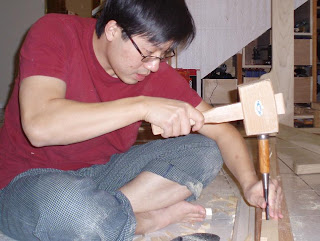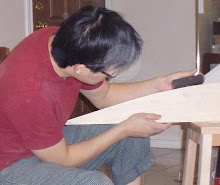
Audrey is from Oklahoma, slender, gray haired and bearded, looks to be in his 80's. He is in fact barely 60 but his life experience added years to his look. We were having lunch, his usual hard candies and cigarettes and me, a burger with a helping of second hand smoke.
I told him I had this great idea about gluing cork boards on the floor of my kitchen. I got the idea because the insert of my handcrafted shoes were made of cork and it’s great on my feet all day. It's supportive yet cushiony. The cork boards self-repairs after you put a pin in it. It doesn't rot from water because that’s why they use it to cork wine bottles and it must be acid resistant because wine doesn't dissolve it. So it should handle all the abuse of the kitchen.
 Audrey lit up another cigarette and spent the next 20 minutes going into detail about the proper care of cork flooring because they were using the stuff since the turn of the century. I'm talking about the 1900s. It just needed to be stripped and wax once a year. Then Linoleum was the big thing, then no wax vinyl took over and that was the death of resilient flooring. Residential use of cork was dead for decades as housewives and husbands forgotten how to wax a floor.
Audrey lit up another cigarette and spent the next 20 minutes going into detail about the proper care of cork flooring because they were using the stuff since the turn of the century. I'm talking about the 1900s. It just needed to be stripped and wax once a year. Then Linoleum was the big thing, then no wax vinyl took over and that was the death of resilient flooring. Residential use of cork was dead for decades as housewives and husbands forgotten how to wax a floor.
I think I'm born too late. I looked up cork flooring on the Internet and it's huge with the green movement. Hypo-allergenic, fire retardant, natural insulation, self sealing, good for your joints, all this and it's good for the environment. All this from a tree!
 So I made my own cork flooring, 99 cents cork boards, glued to the slab with resilient flooring glue, four or five coats of polyurethane and two coats of wax. The first two pictures shows my homemade cork flooring, the third picture is the manufactured floating I was able to special order from Lowes for about $3.50 a sf. I put it all over the upstairs and lined the stairs with it. I didn't know how to make stair nosing out of cork, so Pine casing will have to do. The contrast is great when you are walking down stairs at night, you can make out the steps.
So I made my own cork flooring, 99 cents cork boards, glued to the slab with resilient flooring glue, four or five coats of polyurethane and two coats of wax. The first two pictures shows my homemade cork flooring, the third picture is the manufactured floating I was able to special order from Lowes for about $3.50 a sf. I put it all over the upstairs and lined the stairs with it. I didn't know how to make stair nosing out of cork, so Pine casing will have to do. The contrast is great when you are walking down stairs at night, you can make out the steps.













